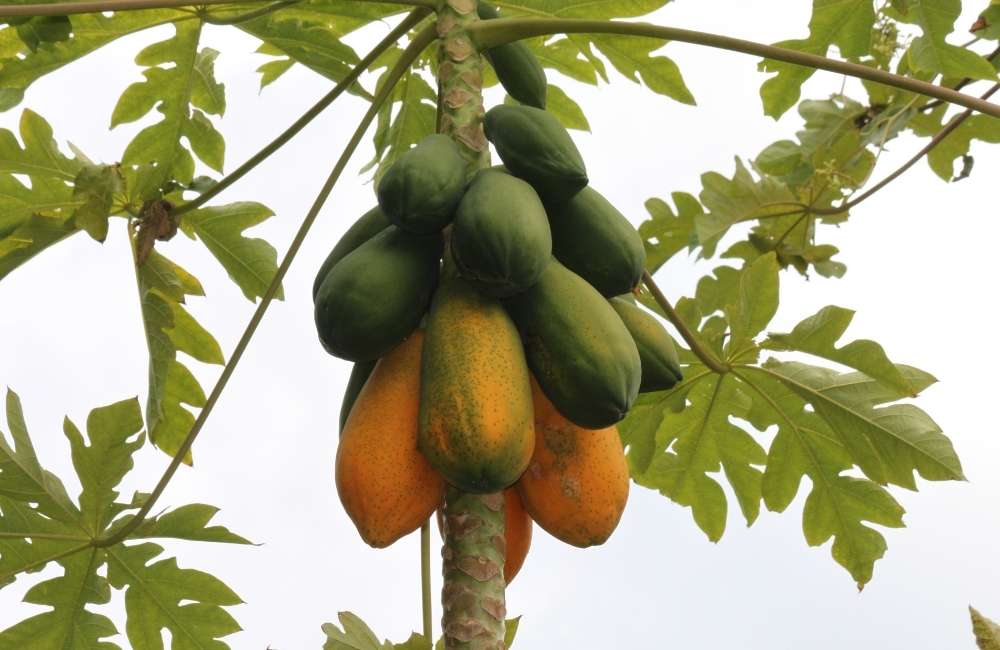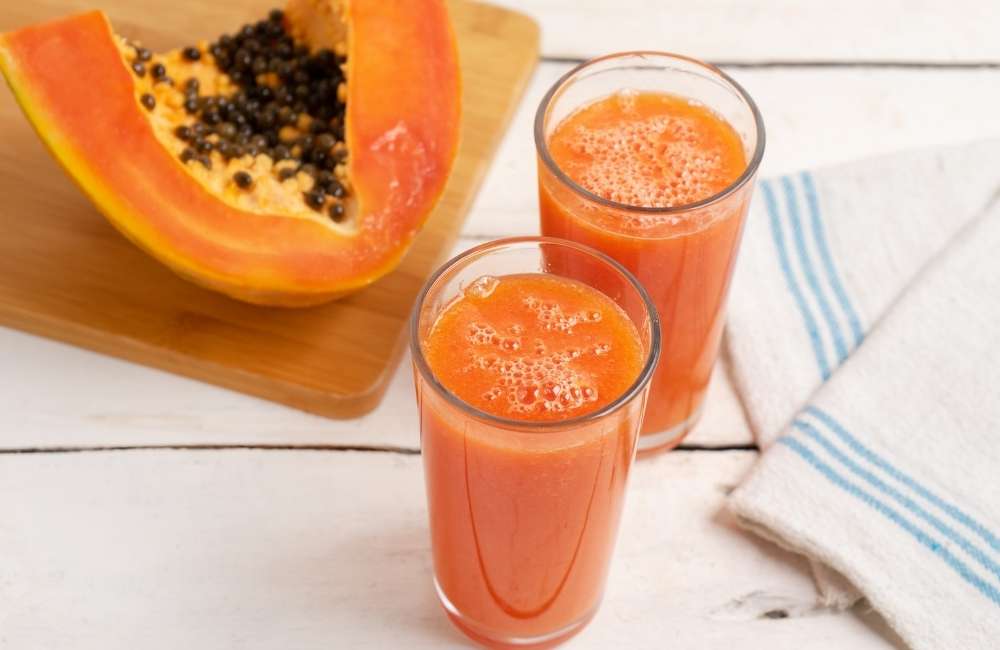Papaya (Carica papaya. L.), commonly called pawpaw is a well-known fruit-bearing plant all over the world. It is a juicy and tasty fruit, belonging to the family Caricaceae. The scientific name is Carica papaya.
This plant is grown in various parts of the world, including India, tropical America, Europe and some parts of Africa. It was considered as an exotic fruit because of its buttery taste and appearance. Papaya was the first genetically modified fruit consumed by human beings for its nutritional and medicinal purposes.
Description of the Plant
The papaya plant is a large, single-stemmed herbaceous perennial tree 20-30 ft. in height. The leaves are very large (up to two and a half feet wide), palmately lobed or deeply incised with entire margins and petioles of 1-3 ft. in length.
Stems are hollow, light green to tan brown with a diameter of 8 inches and bear prominent leaf scars. The fruits are big and oval. Fruits are borne axillary on the main stem, usually singly but sometimes in small clusters.
Fruits weigh from 0.5 to 20lbs. They are green until ripe, turning yellow or red-orange. The flesh is yellow-orange to salmon (pinkish-orange) at maturity. The edible portion surrounds the large, central seed cavity. Individual fruits mature in 5-9 months, depending on the specie and temperature.
The plants begin bearing fruits in 6-12 months. The flowers can be only male, female or bisexual. The bisexual flowered plants are self-pollinating, but the female plants must be cross-pollinated by either bisexual or male plants.
The Nutritional Content of Papaya
Papaya (also called pawpaw) is packed full of vitamins and minerals. It is an excellent source of:
- Vitamin C
- Vitamin A
- Vitamin E
- Vitamin K
- Protein
- Fat
- Carbohydrate
- Fibre
It was seen through analysis that 100 grams of ripe papaya consist of 32 calories, 0.6g of protein, 0.1g of fat, 7.2g of carbohydrate and 2.6g of fibre. The fruit is filled with antioxidants, which help to reduce inflammation, fight a host of diseases, and keep wrinkles at bay.
Phytochemical Constituents of Papaya

Carica papaya contains many biologically active compounds. The two important compounds are Papain and Chymopapain, which aid digestion. The concentration of the compounds varies in the fruit, latex, leaves and roots. The phytochemicals from male and female trees differ in quantity. For example, phenolic compounds tend to be higher in male trees than in female trees.
It also contains a broad spectrum of phytochemicals including polysaccharides, minerals, enzymes, proteins, alkaloids, glycosides, fat and oils, lectins saponins, flavonoids and steroids. The phytochemical analysis of Carica papaya fruits revealed the presence of phytochemicals, including kaempferol, quercetin and caffeic acid.
Health Benefits of Papaya
Different parts of the papaya plant are employed in the treatment of different human and veterinary diseases in various parts of the world. In Asian folk medicine, its latex is employed as an abortifacient, antiseptic for wound dressing, and a cure for dyspepsia.
In Africa, the root infusion is reputed for treating venereal diseases, piles and yaw. In Cuba, its latex is used for the treatment of psoriasis, ringworm, and cancerous growth.
There are many benefits of superfoods like papaya, which translates to its use to maintain and keep the body healthy, especially through the prevention of some illnesses. Let us have a look at some of the potential benefits and some activities of the extracts of some of the parts:
-
May Reduce the Risk of Alzheimer’s Disease
Alzheimer’s disease is a progressive neurodegenerative disease that kills brain cells. It causes memory problems and a gradual loss of intellectual abilities. The exact cause is not known. It was found in a study that extracts of fermented papaya powder may help counteract the effects of oxidative stress in people living with Alzheimer’s disease and slow the progression of the illness. The whole plant was not studied for this.
-
May Protect Against Certain Types of Cancer
Free radicals and oxidative stress are closely related to different types of cancer. The antioxidant activity of papayas can help protect cells from damage and lower the risk of cancer. Its lycopene content can help to lower cancer risk.
Lycopene is a carotenoid and natural pigment that gives some vegetables and fruits their colour. Papaya equally contains beta-carotene and it was found in one study that beta-carotene offers protection from prostate cancer.
-
Help to Boost The Immune System
This fruit is an excellent source of Vitamin C. It contains more than 200% of your daily dose of Vitamin C. Therefore, eating it can boost your immune system and protect your body from a variety of illnesses and infections, including scurvy. Vitamin C is essential in creating collagen, which in turn helps in connecting bodily tissues.
-
Potentially Protects The Heart
Papaya contains vitamin C, potassium, antioxidants and fibre, which help keep the arteries healthy and promotes blood flow. This can also lower cholesterol and reduce your risk for heart disease, high blood pressure, and stroke.
-
Aids in Lowering Blood Sugar
Some studies have found that papaya has a hypoglycemic effect on the body, decreasing blood glucose levels. If you have type II diabetes and are looking for ways to help lower your glycosylated haemoglobin ( HBA1C )-a two- to three-month average of your blood sugar levels, it may help you to achieve your goal.
Papaya fruit is low in GI and high in fibre, thus preventing blood sugar from rising in diabetics. Flavonoids are natural antioxidants found in fruit that may aid with blood sugar regulation.

-
Lowers Cholesterol
Papayas are rich in fibre, antioxidants and Vitamin C, which help in the prevention of increased cholesterol in your arteries. Too much cholesterol leads to several coronary diseases, including heart attack, stroke and hypertension.
The fibre in the fruit helps control blood pressure and also regulates the levels of LDL (the unhealthy cholesterol) in the blood. Fibres also ensure smoother digestion, add bulk to the stool and facilitate bowel movement.
-
Papaya May Aid in Weight Loss
It is low in calories and a good source of fibre along with low GI. The fibre content that is present in papayas keeps you feeling full for a long time, thus reducing cravings.
-
May Protect Against Arthritis
The papain content in papaya is a potent anti-inflammatory agent. It has been found useful in lowering joint pain and stiffness, therefore an excellent supplement for anyone with arthritis.
It also benefits people who are at risk of developing arthritis.
-
Improves Eyesight
Papaya fruit is rich in Vitamin A, which helps your eyesight tremendously, especially in old age where macular degeneration is rampant. Zeaxanthin, a powerful antioxidant important in human vision, is found in papaya flesh.
-
Papaya Prevents Wrinkles and Signs of Aging
This fruit is a rich source of Vitamin C and it helps build collagen in your body, resulting in your tissues binding together. It is said that eating a bowl of papaya every day can ensure that you look at least five years younger than your actual age.
-
Reduces Stress
Papaya helps in regulating the flow of stress hormones through Vitamin C. It is recommended to have a bowl of papaya every day if you are always stressed out at work.
-
Eases Menstrual Pain
Menstrual pain in women is characterized by severe cramps and eating papaya regularly helps to ease the cramps as the fruit helps the flow of menstrual blood.
-
Help in Managing Sickle Cell Disease
Sickle cell disease results from a mutation in haemoglobin inside the red blood cells. Recent studies have shown that unripe papaya fruit extract has anti-sickling properties
-
May Help in Wound-Healing
Diabetic wounds are slow, non-healing wounds that can persist for weeks despite adequate and appropriate care. It was discovered that the aqueous extract of papaya leaves has wound-healing potential. Traditionally, papaya is a herbal treatment in developing countries for burns, soft tissue wounds and skin infections.
Miscellaneous Uses of the Papaya Plant
Papaya is cultivated for its edible ripe fruits.
- Juice is a popular beverage.
- The fruits are a source of flavouring used in candies, jellies, preserves and ice cream.
- Shallow cuts on the surface of fully grown but unripe fruits cause a milky sap or latex to ooze that is collected, dried and termed “crude papain”. Papain has many industrial uses, as well as milk-clotting (rennet) and protein-digesting properties. Nearly 80% of American beer is treated with papain, which allows the beer to remain clear upon cooling.
- Papain is commonly used commercially in meat tenderizers and chewing gums.
- Cosmetically, papain is used in some toothpaste, shampoos and facial creams.
Caution When Using Papaya
Papaya may cause severe allergic reactions in sensitive people otherwise papaya juice and seeds are unlikely to cause adverse effects when taken orally. Let us explore where to apply caution when using these plant parts.
- Papaya latex can be a severe irritant and vesicant on the skin.
- Papaya seeds at high doses may cause poisoning because of benzyl isothiocyanate content.
- Papaya leaves at high doses may cause stomach irritation.
- Unripe papaya fruit can induce abortion or labour in pregnant women therefore should be avoided if pregnant.
- Papaya seed extract can reduce fertility because it has contraceptive and abortifacient activities.
Conclusion
Papaya is well known for its exceptional nutritional and medicinal properties throughout the world. There is no part of this plant that is not useful in traditional medicine, the leaves, seeds, roots, and ripe and unripe fruits. Papaya is considered a Nutraceutical fruit due to its multifarious medicinal properties.
There is no report of toxicity when consumed normally over a long period except that it may cause infertility. Papaya is a super healthy food that should be consumed daily. Thank you.

